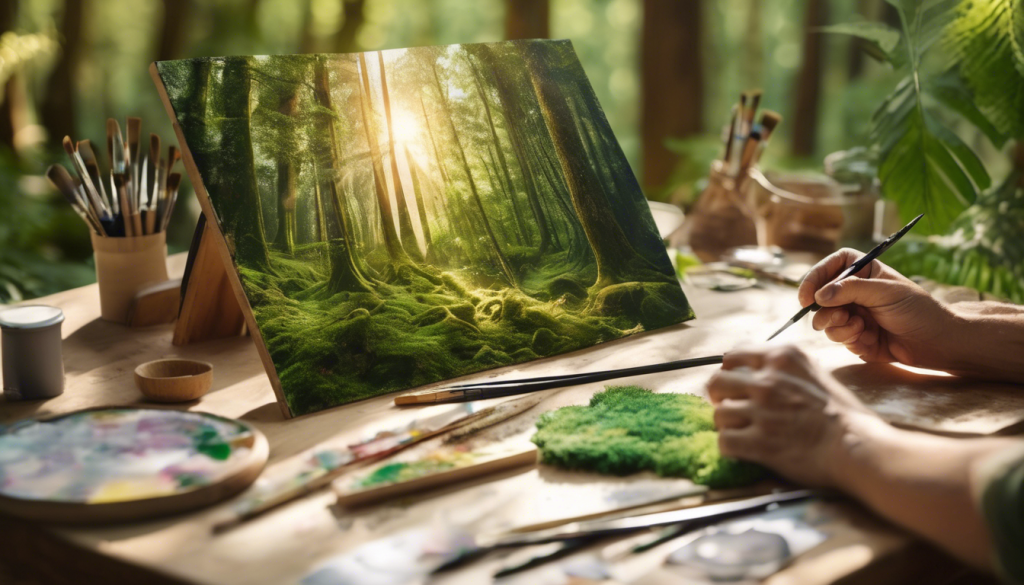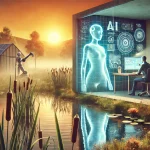
Navigating the Creative Frontier: How Generative AI is Reshaping Creative Industries in 2025
The boundary between human creativity and artificial intelligence is becoming increasingly blurred. In 2025, generative AI has evolved from a curiosity to an essential tool across creative industries, transforming how art, music, writing, and design are produced. But this technological shift brings both unprecedented opportunities and complex challenges for creative professionals.
The State of Generative AI in Creative Industries
Generative AI has experienced explosive growth, with adoption rates skyrocketing from 33% in 2023 to 71% of organizations in 2024, according to McKinsey’s State of AI report. This surge is backed by substantial financial commitment—investment in generative AI nearly doubled in 2023, reaching $25.2 billion as reported by Planable.
The impact spans multiple creative domains:
- Visual Arts and Design: AI tools now generate images, create brand assets, and assist in complex design processes
- Music: AI systems compose original pieces and help musicians develop new sounds
- Writing: Generative models produce everything from marketing copy to creative fiction
- Film and Visual Effects: AI enhances production workflows and creates visual elements that would be time-consuming to develop manually
The economic potential is significant—generative AI is expected to add between $2.6 trillion and $4.4 trillion annually across industries according to Dulandias.
Tools Transforming Creative Work
The landscape of AI tools for creative professionals has expanded dramatically in 2025:
For Visual Content
- Adobe Firefly: Integrated into Creative Cloud, it offers AI image generation with stylistic options familiar to creative professionals, as noted by CNET
- DALL-E 3: OpenAI’s image generator provides extensive editing tools and customization options
- Canva’s Magic Media: A user-friendly AI image generator that integrates with other Canva tools
For Text and Content
- Jasper: Generates blog posts, social media captions, and marketing copy in over 30 languages
- Copy.ai: Offers 90+ templates for various content types with support for 29+ languages
- AIContentfy: Focuses on scalable content creation tailored to specific tones and styles
For Audio and Video
- Synthesia: Creates AI-powered text-to-video content in 65 languages
- Beatoven: Generates unique, royalty-free music for videos and podcasts
- ElevenLabs: Offers high-quality AI voiceovers and audio assets
For Development and Design
- GitHub Copilot: Provides intelligent code suggestions and automated code completion
- Venngage’s AI Tools: Help designers create multiple design variations based on initial concepts
Successful Human-AI Collaborations
Despite concerns about AI replacing human creativity, many successful collaborations demonstrate how humans and AI can work together effectively:
In February 2025, The Guardian Media Group announced a strategic partnership with OpenAI to incorporate The Guardian’s journalism into ChatGPT’s platform. According to Crescendo AI, this collaboration allows The Guardian’s reporting to reach ChatGPT’s global users through attributed summaries and article extracts.
The Hailo Hackathon 2024-2025 showcased innovative projects where developers created AI-generated MIDI music, AI-driven smart camera tracking, and AI-driven outfit recognition using the Hailo AI HAT on Raspberry Pi. As reported by Hailo, these projects highlighted the potential for edge AI to create impactful and creative solutions.
Dubformer, an AI-powered dubbing startup that secured $3.6 million in funding in March 2025, leverages AI to provide seamless dubbing for media content, reducing language barriers in entertainment and education. This demonstrates how generative AI can enhance media accessibility and facilitate global content reach.
How Small Businesses and Freelancers Are Adapting
Generative AI is democratizing creative capabilities, enabling small businesses and freelancers to compete with larger companies:
- Enhanced Content Creation: Small agencies can now produce high-quality content without large teams or budgets. According to Robin Waite, AI tools like animated character generators help create custom characters, making branding more engaging and accessible.
- Data-Driven Marketing: AI tools analyze customer data more effectively, identify trends, and optimize marketing strategies, helping small businesses improve engagement and conversions. Pipedrive offers an AI Sales Assistant that uses predictive analytics to assess deal win probability and recommend next steps.
- Workflow Efficiency: AI handles routine tasks like scheduling social media posts or sorting emails, allowing creative professionals to focus on strategy and high-value work.
Ethical Concerns and Copyright Challenges
The rapid adoption of generative AI has raised significant ethical and copyright concerns:
Copyright Issues
Recent events highlight these challenges. In March 2025, ChatGPT’s new image generator created viral Studio Ghibli-style images that sparked controversy. As reported by 2 News Nevada, Studio Ghibli founder Hayao Miyazaki had previously expressed that he would “never wish to incorporate this technology into my work at all,” calling certain AI applications “an insult to life itself.”
This raises questions about whether AI models were trained on copyrighted works without permission. Josh Weigensberg, a partner at law firm Pryor Cashman, noted that while “style” is generally not copyrightable, what people consider “style” might include “specific, discernible, discrete elements of a work of art” that could be protected.
Other Ethical Concerns
- Erosion of Human Creativity: Over-reliance on AI for creative tasks could diminish the value of human creativity and originality, potentially homogenizing cultural and creative works, according to research by AIMutliple.
- Unemployment and Workforce Impact: The adoption of generative AI could displace human jobs in creative fields, leading to economic shifts.
- Deepfakes and Misinformation: Generative models can create realistic media that are difficult to distinguish from authentic content, raising concerns about misinformation.
Educational Adaptation and Future Skills
Educational institutions are rapidly evolving to prepare creative professionals for this AI-integrated future:
- Johns Hopkins University has launched a 16-week online course in Applied Generative AI, designed to help professionals leverage AI for business innovation, as reported by JHU Lifelong Learning.
- Seton Hall University is integrating AI into its professional development programs, offering courses like Digital Content Creation and Generative AI, equipping learners with skills to lead in an AI-driven workforce according to Seton Hall.
- Arizona State University is taking a systems approach to AI integration, offering professional development courses that encourage faculty to experiment with AI tools.
Consumer Response to AI-Generated Content
How are audiences responding to AI-generated creative content? The landscape is evolving:
- Personalization and Relevance: AI enables hyper-personalization, which significantly improves engagement and conversions. According to Microsoft Ads, generative AI solutions help deliver tailored experiences based on unique search intent, preferences, and context.
- AI in Marketing: By 2025, AI chatbots are expected to manage up to 85% of customer interactions, enhancing efficiency and customer service, as noted by Content Grip.
- Ethical Considerations: Consumers are increasingly concerned about data privacy and transparency in AI-generated content, leading companies to develop guidelines for responsible AI use.
What This Means For You
For Creative Professionals
- Skill Evolution: Focus on developing skills that complement AI rather than compete with it—creative direction, emotional intelligence, and strategic thinking will remain uniquely human strengths.
- Ethical Awareness: Stay informed about copyright issues and ethical considerations when using AI tools in your creative process.
- Collaboration Mindset: View AI as a collaborative partner rather than a replacement—the most successful approaches combine human creativity with AI efficiency.
For Small Businesses
- Start Small: Begin with user-friendly AI tools that require minimal technical expertise, gradually incorporating more advanced options as your comfort level increases.
- Focus on Strategy: Use AI to handle routine tasks while you focus on strategic decisions and creative direction that require human judgment.
- Continuous Learning: Invest time in understanding new AI capabilities as they emerge—this knowledge will be a competitive advantage.
Getting Started
- Experiment with Free Tools: Many AI platforms offer free tiers or trial periods—use these to explore capabilities without significant investment.
- Join AI Communities: Connect with other creative professionals using AI to share experiences and best practices.
- Take Specialized Courses: Consider courses specifically designed for creative professionals looking to integrate AI into their workflows.
Looking Forward
The integration of generative AI into creative industries is not just changing how we create—it’s expanding what’s possible. While challenges remain around ethics, copyright, and the evolving nature of creative work, the potential for innovation and accessibility is unprecedented.
As AI continues to evolve, the most successful creative professionals will be those who embrace these tools while maintaining their unique human perspective. The future belongs not to AI alone, nor to those who reject it entirely, but to those who learn to collaborate effectively with these powerful new creative partners.
What’s your experience with generative AI in your creative work? Have you found ways to collaborate effectively with these tools? Share your thoughts and experiences in the comments below.
Related Resources
- The State of AI in 2025: McKinsey’s Comprehensive Report
- Ethical Guidelines for AI in Creative Industries
- AI Tools for Beginners: A Practical Guide


